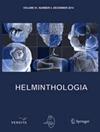First molecular observation on Mylonchulus hawaiiensis from South Africa
IF 1.2
4区 生物学
Q4 PARASITOLOGY
引用次数: 0
Abstract
Summary During a survey of soil nematodes in South Africa, a species of predatory nematodes, namely首次从分子角度观察南非的 Mylonchulus hawaiiensis
摘要 在对南非土壤线虫进行调查期间,从南非林波波省 Magoebaskloof 山的土壤中发现了一种掠食性线虫,即 Mylonchulus hawaiiensis。研究材料的形态与该物种以前的种群十分吻合。哈瓦伊蝇 18S rDNA 区域的分子研究表明,南非种群与日本哈瓦伊蝇种群(AB361438;AB361439;AB361440;AB361442)的相似度为 100%。此外,系统进化分析还将所有哈瓦伊蝠鲼归入一个组,后验概率为 0.97。此外,还首次扩增了哈瓦伊蝠的 ITS rDNA。然而,主成分分析(PCA)显示,M. hawaiiensis 不同种群之间存在形态差异。此外,单倍型分析还显示南非种群与日本种群接近。总之,18S rDNA 是检测 M. hawaiiensis 的良好标记。本文给出了南非哈瓦伊蝠的测量值、照片和系统发育位置。
本文章由计算机程序翻译,如有差异,请以英文原文为准。
求助全文
约1分钟内获得全文
求助全文
来源期刊

Helminthologia
生物-动物学
CiteScore
1.80
自引率
0.00%
发文量
21
审稿时长
>12 weeks
期刊介绍:
Helminthologia (HELMIN), published continuously since 1959, is the only journal in Europe that encompasses the individual and collaborative efforts of scientists working on a different topics of human, veterinary and plant helminthology. The journal responsibility is to enrich the theoretical and practical knowledge in very specific areas and thus contribute to the advancements in human and veterinary medicine and agronomy. Taking the advantage of comprehensive and multidisciplinary approaches journal still maintains its original spirit and is principal source of fresh scientific information regarding helminths, endoparasites and plant parasites. Addressing the most up-to date topics journal gained rightful and exceptional place next to the other high-quality scientific journals publishing in its field.
 求助内容:
求助内容: 应助结果提醒方式:
应助结果提醒方式:


